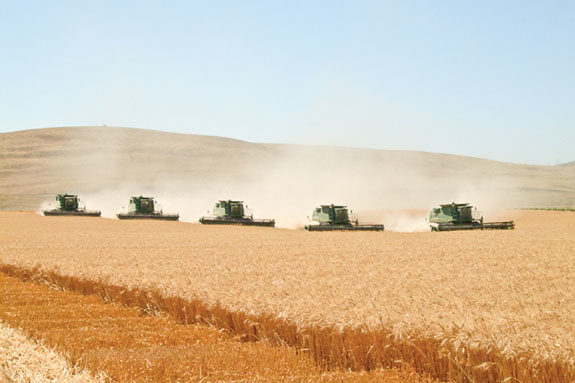Since her father, Elmer, started the family business in 1949, the Altendorfs offered farmers the option to provide at least some of their own support equipment to make their harvesting services affordable.
In recent years, fewer and fewer farmers are making use of that offer.
“That’s especially true in South Dakota and Iowa,” Jan says. “We used to see about 75 percent of farmers in those states who furnished their own equipment.
Now, in those states, we’re seeing many of those implements are committed to other farm activities and they’re just not available at harvest time. Often they’re being used for livestock chores.”
When Jan’s father began the business, he was answering a call from the U.S. government that went out during war time. Farmers across the country were asked to do whatever they could to assist farmers in the South bring in their harvest.
“My dad and his brother loaded up the combine and headed south,” Jan says. “We’ve been helping with harvest ever since.”
Jan and her brothers, Martin and Marvin, all grew up working on the harvest crew with their father. Each has taken their turn operating the business. In recent years the boys took over the trucking business their father also established. They utilize more than 100 trucks traveling across the nation.
“I stuck with the harvesting,” Jan says. “I guess I have a little more gypsy blood than they do.”
Altendorf Harvesting begins their harvest tour in Texas, then divides their equipment to harvest in the northwest, up through the plains states and in some western states.
In the southern states where the Altendorfs work, their customers often don’t own the support equipment necessary to bring in the harvest. They rely more on the harvesting crew to furnish it.
“It’s more beneficial to us when farmers do furnish part of their own support equipment,” Jan says. “It’s less labor for us, because they usually provide their own operators. It’s also less investment for us.
With combine costs averaging $350,000 and tractor and gravity wagon costs around $300,000, we make our investments carefully to keep our costs down.”
A growing trend Jan sees in her customer base is farmers with their own combines and support equipment bringing in her crew and equipment to shorten the harvest time.
“That works well for a number of reasons,” Jan says. “The farmer can sample their crop before they bring us in so they’re not getting us there too early. If there are weather issues before we’re done, we can move on and the farmer can finish his harvest when the weather clears.
In those situations, we both supply some equipment. With today’s mapping systems, we’re able to closely monitor the percentage of harvesting we complete so we can charge fairly for the work we’ve done.”
Strong commodity prices over the last few years have driven a growing demand for harvesting services. The majority of farmers in Jan’s customer base harvest a large number of acres and repeat business has been a strength of the business for many years.
“Smaller farmers search for alternatives to harvesting services when prices are down,” Jan says. “That’s especially true if yield is down at the same time. They’ll find a neighbor to do it or maybe purchase used equipment and do their own harvesting.”
Among the strengths of the Altendorfs’ business is their attention to customer needs and focus on daily equipment maintenance.
“We rotate equipment every year, which keeps us under warranty,” Jan says. “We used to grease everything every day. Newer equipment has built-in grease zerks. We blow everything off and refuel.
We have a mechanic on the ground and one person who monitors rotation of service work and takes care of tires. The majority of maintenance work is done on the head, making sure that’s operating properly.”
A rule of thumb that has served the crew well has been careful use of equipment farmers provide. Whenever possible, they utilize operators the farmer supplies.
“Most of the time farmers want their own operators in their equipment,” Jan says. “That’s the way we prefer it, too. If we do supply an operator, we make sure it’s someone who’s very experienced.
We take more caution operating the farmers’ equipment than with our own.”
With all the attention to detail, Jan says breakdowns and equipment damage is rarely seen during their annual harvest tour.
“If it’s an operator error and a farmer’s equipment is damaged, we take responsibility,” Jan says. “If it’s a mechanical issue, farmers take care of that. You can tell pretty easily if a problem is mechanical or abuse.
We don’t see either one very often. Most farmers are very particular about who they allow to operate their equipment. We operate in that same way.”
With all the “peaks and valleys” of the agriculture industry, Jan says harvest crews have to love what they’re doing in order to come back to it year after year.
“You’re on the road for seven months, away from your home and family. That’s not always easy,” she says. “It takes a lot of diligence to do it well. In the winter months our time is spent planning and preparing for the upcoming harvest season. We do a lot of training in the winter.”
“My father started out with one combine in the ’50s and now we run 30,” she adds. “We recently opened a new office in Fargo to accommodate our growing business. We get as creative as we can to make our service available to farmers. That’s how our business has always been operated.” FG











